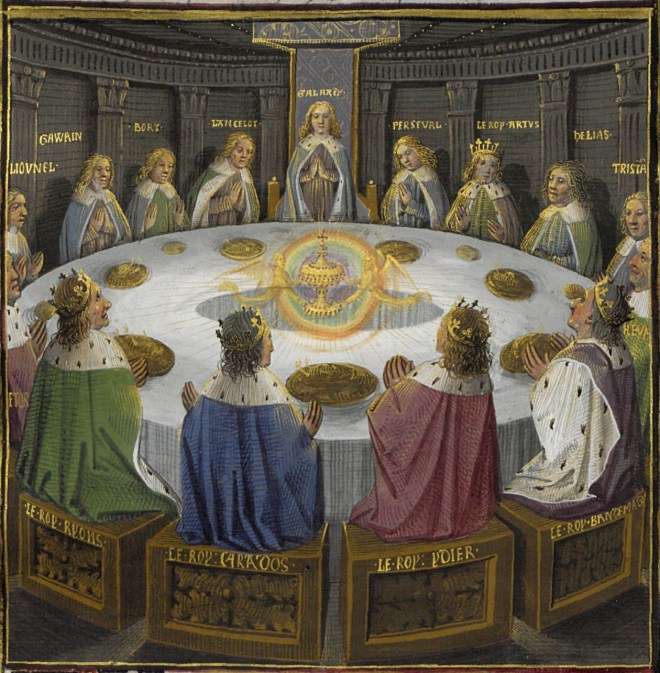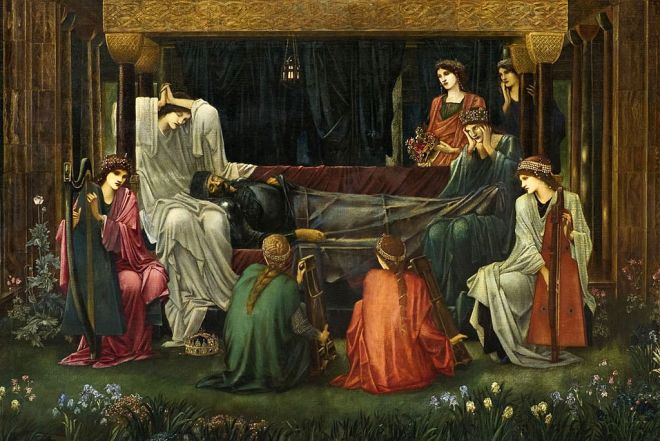 One of my great sources for this blog has been Robert Chambers, who published his ‘Chambers Book of Days’ in 1869. It’s full of absolutely fascinating characters and events that I’d never heard of. Today, he informed me that on this day in the year 542, King Arthur died. Obviously, I have heard of King Arthur, but he then went on to describe an Arthur I didn’t recognise at all.
One of my great sources for this blog has been Robert Chambers, who published his ‘Chambers Book of Days’ in 1869. It’s full of absolutely fascinating characters and events that I’d never heard of. Today, he informed me that on this day in the year 542, King Arthur died. Obviously, I have heard of King Arthur, but he then went on to describe an Arthur I didn’t recognise at all.
Robert based his entry on the account of the king written by Geoffrey of Monmouth in his ‘Historia Regum Britanniae’, published some time around the 1130s. Geoffrey’s Arthur defeated the Saxon invaders and made them promise to leave. Then he went to fight the Picts and Scots and eventually forced them all to live on the islands of Loch Lomond. But the lying Saxons had just sailed around the coast a bit and landed again at Totnes in Devon. So Arthur marched back from Scotland and defeated them again. After that, he conquered Ireland, Iceland and the Orkney islands and then Norway, Denmark and Gaul. His conquest of Gaul, which was then still under Roman control, upset the Emperor and he went to war with him too. Arthur and his knights won, but just as they were about to march on Rome, he heard that his nephew, Mordred, who he had left in charge of Britain had married his queen, and seized the throne. So he went home. That was how his final battle with Mordred happened, and how he came to be mortally wounded and taken to the Isle of Avalon. Who is this pro-active Arthur, rampaging across Europe like an early version of Genghis Khan?
Geoffrey of Monmouth’s story does contain some elements that I do recognise. He tells us that Arthur was conceived at Tintagel in Cornwall with the help of Merlin the magician and that his father was Uther Pendragon. He also implies that Arthur did not die, but merely passed on the crown, was taken to Avalon to be healed of his wounds and was never seen again. Not many people think that his account is in any way true. His near contemporary William of Newburgh, the man who told us about the Green Children of Woolpit and about revenants who returned from the grave to terrorise their communities, reckoned he made it all up. He said:
“Only a person ignorant of ancient history would have any doubt about how shamelessly and impudently he lies in almost everything.”
 Geoffrey’s work does have its sources though. ‘Historia Brittonum’ was written in the ninth century. It is the where we find the story of how Britain was settled by the descendants of Aeneus who fled Troy. Arthur is mentioned here not as a king, but as a warrior. He fights, not only Saxon invaders but also dragons, giants, witches, dog-headed people, cat monsters and even an enchanted poisonous boar with a pair of scissors in its head.
Geoffrey’s work does have its sources though. ‘Historia Brittonum’ was written in the ninth century. It is the where we find the story of how Britain was settled by the descendants of Aeneus who fled Troy. Arthur is mentioned here not as a king, but as a warrior. He fights, not only Saxon invaders but also dragons, giants, witches, dog-headed people, cat monsters and even an enchanted poisonous boar with a pair of scissors in its head.
Meanwhile, in France, the story of Arthur was developing in a different direction. In the twelfth and thirteenth centuries, the stories focused more on the adventures of his knights such as Lancelot, Galahad and Gawain. This is where we find the introduction of the Holy Grail into the legend and Lancelot’s affair with Guinevere. Arthur became a wise, dignified and frankly rather dull king. A cuckold who was sidelined in his own legend. His nemesis, Mordred became his own son who was the result of an incestuous relationship with his sister. His perfect Utopian court was destroyed by his personal flaws. This version of Arthur became rather fixed in Thomas Malory’s ‘Le Morte d’Arthur’ in the late fifteenth century.

During the Renaissance, people became less keen on medieval romances, but interest in Arthur’s story continued when the Tudors tried to claim that they were descended from him. By the eighteenth century, there was more enthusiasm for the classical texts of Greece and Rome and he rather fell out of favour.
All that changed in the nineteenth century though, when the romantics came along. Le Morte d’Arthur was republished in 1816 for the first time in almost 200 years. Nineteenth century gentleman built an entire code of ethics around the chivalric ideals found in the romantic portrayals of King Arthur’s court. When Alfred Lord Tennyson published his reworking of the Arthurian legend ‘Idylls of the King’ in 1859, it sold 10,000 copies in the first week. This Arthur was a huge influence on the Pre-Raphaelites and their imitators well into the twentieth century.
Arthur has reappeared in various guises throughout the twentieth century, in novels on stage and on film. Maybe the real Arthur, whoever he was, really did die on this day in 542, but we’ll probably never know who he really was. He seems a bit quiet at the moment, but he’s probably sleeping under a hill somewhere, ready to pop up again soon.
